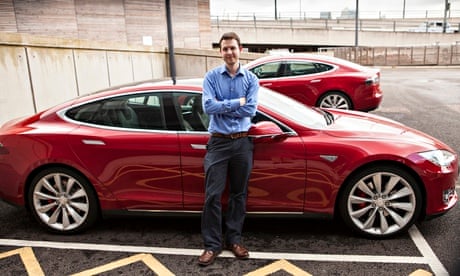My first encounter with the electric car that may even answer Jeremy Clarkson's objections to such vehicles, was an intriguing one. The Tesla Model S looks like a swish saloon car, not a bug or bubble-car like so many other electric vehicles, and it has enough power to beat even the Aston Martin Rapide, all without petrol and with no emissions.
The first Model S, the follow-up to Tesla Motor's Roadster electric sports car, has finally rolled into the UK, two years after going on sale in the US. The launch at London's Crystal, opposite the O2, was hosted by the flamboyant serial Silicon Valley entrepreneur and chief executive Elon Musk. It marks the first time the car has been available in right-hand drive and hails the start of a new future for electric cars that may actually fit into people's lives. That is, if they can stomach the asking price: £49,900, for starters.
Tesla was founded by Musk, of PayPal then SpaceX fame, which became the first commercial spaceflight company to launch and dock a spacecraft with the International Space Station in 2012.
Musk has headed Telsa since 2008 and famously rowed with Clarkson on the BBC's Top Gear show over the handling of the Model S's predecessor, the £87,000 Roadster sports car in 2008.
Since its US release in June 2012, Tesla has sold more than 25,000 of the five-door Model S electric cars worldwide, backed by a network of the company's proprietary superchargers which can rapidly charge the Tesla's batteries giving up to a 170 mile top up in 30 minutes and a full charge in 70 minutes, compared to the standard 15-hour or overnight affair for at-home charging.
The supercharger network is Tesla's big draw, making an electric car with limited range practical. In Europe, the stations only number 19 - compared with 94 in the US - with most in Germany and Norway. But that is set to change as Tesla places free supercharging stations along the UK's busiest routes. The current plan is to cover from Dover and Bristol up to the M25 and north along the M1, with an inner-city London network and the south covered in three months, England in six months, and the whole of the UK and Ireland covered by superchargers in 18 months. Tesla says Model S owners will be able to drive the length of the UK with one 20-minute top up mid-way.
With only 1,500 electric cars registered in the first quarter of 2014, the government hopes that Musk, the "electric car tsar", and his luxury electric saloon will boost electric cars.
"The goal at Tesla is to produce a mass market electric car, but we can only get there one step at a time by selling the Roadster and now the Model S to fund the mass market," said Musk.
The Model S is set to compete with the BMWs and Mercedes of this world, and its futuristic, swooping styling provides a good-looking change to the German cars' hard lines. That almost sci-fi feel is maintained as you approach the car and see the door handles pop out automatically.
Inside it's all premium Silicon Valley technology. Musk likes to think of Tesla as the "Apple" of cars, which might explain why there is what looks like a large iPad complete with Apple-style graphics where the centre console should be. The 17in touchscreen controls almost everything about the car, from the air conditioning and music to opening the sunroof and firing up the heated windscreen wipers.
Below the screen the floor is entirely flat, while in front of the driver the traditional gauges and dials are replaced by digital instruments displaying battery charge, power usage, range and speed – no rev counter needed.
There's no key hole or start button to speak of. Simply placing the car in drive with the key somewhere on your person kickstarts the car into life. Place your foot on the accelerator and off you rush.
"The Model S will do 0-60mph in 4.2 seconds powered by a motor the size of a lady's handbag," quipped Georg Ell Tesla's UK director.
It is a thrilling rush reaching 60mph as fast as a Lamborghini Gallardo, throwing you and your passengers back into their seats. The only real difference is that there is no roar of the engine, just a squeal of the tyres on the road, a space for five passengers with all their luggage.
But beyond that, driving the Model S is as easy as any other car despite the power under the hood. There are no gears, no automatic gear box to deal with, just a surge of constant power that only a linear electric motor can provide. Mark me impressed, this is no G Whiz or Nissan Leaf, this is the Aston Martin or Audi of the electric car world. However, the car certainly feels heavy and despite a low centre of gravity you can feel it in the corners, as you would any large performance saloon.
Prices start at £49,900 for the 60kWh version rising to £69,080 for the 85kWh Performance model and £98,000 with all the options. Tesla's battery warranty spans eight years – even if the battery is damaged by user negligence, while the car comes with a four-year warranty.
Claims of zero emissions are slightly disingenuous, given that the electricity has to come from somewhere. Attached to the British domestic supply it will still contribute at least 85g/km of carbon to the environment costing around £10 to fully charge. The average new car in the UK emits 128.3g/km in 2013 according to the Society of Motor Manufacturers and Traders, however.

Comments (…)
Sign in or create your Guardian account to join the discussion